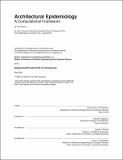| dc.contributor.advisor | Takehiko Nagakura. | en_US |
| dc.contributor.author | Peraino, Jim. | en_US |
| dc.contributor.other | Massachusetts Institute of Technology. Department of Architecture. | en_US |
| dc.contributor.other | Massachusetts Institute of Technology. Department of Electrical Engineering and Computer Science. | en_US |
| dc.date.accessioned | 2020-10-08T21:28:22Z | |
| dc.date.available | 2020-10-08T21:28:22Z | |
| dc.date.copyright | 2020 | en_US |
| dc.date.issued | 2020 | en_US |
| dc.identifier.uri | https://hdl.handle.net/1721.1/127877 | |
| dc.description | Thesis: S.M., Massachusetts Institute of Technology, Department of Architecture, May, 2020 | en_US |
| dc.description | Thesis: S.M., Massachusetts Institute of Technology, Department of Electrical Engineering and Computer Science, May, 2020 | en_US |
| dc.description | Cataloged from the official PDF of thesis. | en_US |
| dc.description | Includes bibliographical references (pages 73-76). | en_US |
| dc.description.abstract | Architecture affects our health, especially in hospitals. However, our ability to learn from existing hospitals to design buildings that improve patient outcomes is limited. If we want to leverage large datasets of health outcomes to build knowledge about how architecture affects health, then we need new methods for analyzing spatial data and health data jointly. In this thesis, I present several steps toward the goal of developing a computational model of architectural epidemiology that aims to leverage both human and machine intelligence to do so. First, I outline the need for structured architectural datasets that capture spatial information in schemas that current drawing formats do not allow. These datasets need to be wide to capture multifaceted and qualitative aspects of the built environment, and so we need new methods to generate this data. Finally, we need strategies for surfacing insight from these datasets by involving both humans and machines in the process. | en_US |
| dc.description.abstract | Next, I propose a framework to satisfy these criteria that consists of four components: 1) data sources, 2) feature engineering, 3) statistical analyses, and 4) decision-making activities. Two case studies provide in-depth illustrations of these components: The first presents a 3D interface that enables developers to create 3D visualizations of large health outcome datasets in architectural space while taking advantage of the Kyrix details-on-demand system's backend performance optimizations. The second tests the efficacy of neural network ablation to surface relationships between architectural characteristics and health outcomes using a synthetic dataset. It is not necessary to ignore human intuition if we want to take advantage of computational power, and it is not necessary to leave behind computational power if we want to take advantage of human intuition. By overcoming current technical barriers with the methods proposed in this thesis, we can work toward achieving both. | en_US |
| dc.description.abstract | Ultimately, we can learn from our current environments to design buildings that improve our health. | en_US |
| dc.description.statementofresponsibility | by Jim Peraino. | en_US |
| dc.format.extent | 76 pages | en_US |
| dc.language.iso | eng | en_US |
| dc.publisher | Massachusetts Institute of Technology | en_US |
| dc.rights | MIT theses may be protected by copyright. Please reuse MIT thesis content according to the MIT Libraries Permissions Policy, which is available through the URL provided. | en_US |
| dc.rights.uri | http://dspace.mit.edu/handle/1721.1/7582 | en_US |
| dc.subject | Architecture. | en_US |
| dc.subject | Electrical Engineering and Computer Science. | en_US |
| dc.title | Architectural epidemiology : a computational framework | en_US |
| dc.type | Thesis | en_US |
| dc.description.degree | S.M. | en_US |
| dc.description.degree | S.M. | en_US |
| dc.contributor.department | Massachusetts Institute of Technology. Department of Architecture | en_US |
| dc.contributor.department | Massachusetts Institute of Technology. Department of Electrical Engineering and Computer Science | en_US |
| dc.identifier.oclc | 1196833084 | en_US |
| dc.description.collection | S.M. Massachusetts Institute of Technology, Department of Architecture | en_US |
| dc.description.collection | S.M. Massachusetts Institute of Technology, Department of Electrical Engineering and Computer Science | en_US |
| dspace.imported | 2020-10-08T21:28:22Z | en_US |
| mit.thesis.degree | Master | en_US |
| mit.thesis.department | Arch | en_US |
| mit.thesis.department | EECS | en_US |
